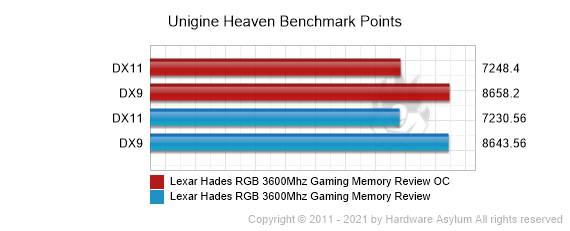Lexar Hades RGB 3600Mhz Gaming Memory Review
Author: Dennis GarciaBenchmarks - Overclocked
As with all of our reviews, we pit the default speed system against the overclocked one in a head-to-head byte match. The only difference is that with our memory reviews we leave the base system (CPU, Chipset etc..) at default speeds so that the only thing we are changing is the memory module. You can see this with the Sandra CPU Tests and at that point the only performance advantage is from increased memory performance.
There are different approaches to overclocking memory. The literal translation is overclocking the physical memory module, timings, speed and voltage. However, it seems that with the lack of real CPU overclocking the extreme overclockers have resorted to overclocking the memory controller and calling it “memory”.
For the average user you will want a “blend” of these two approaches and then be 100% prepared for neither of them to work nor give you any significant results. In addition, smaller module densities tend to overclock better than larger modules.
The effective overclock for these tests was 3733Mhz with no voltage or timing adjustments.







Memory overclocking is a pretty arduous task of trial and error. As with most system overclocking the balance we want to maintain is a relationship between temperature, voltage and frequency. Chip quality will sway the balance and is where we normally land in terms of overclocking stability.
To be honest I am a little surprised that I could get the modules to overclock at all considering the density of the modules and that these are the fastest in the series. During my tests I found that any timing changes would kill the system and voltage adjustments were not that helpful. I am also a little disappointed because 3600Mhz is pretty slow when it comes to performance memory. However, the modules responded well to minor frequency adjustments and offered a slight gain in overall performance across the board.

